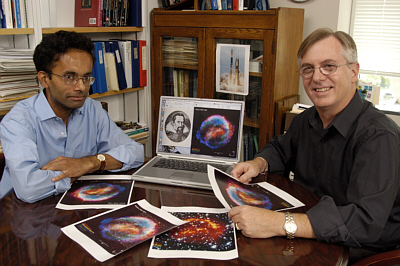|
Back..
Kepler's Supernova
1604 Supernova |
 Ravi Sankrit and William Blair |
|
Office of News and Information Johns Hopkins University 901 South Bond Street, Suite 540 Baltimore, Maryland 21231 Phone: 443-287-9960 | Fax: 443-287-9920 |
October 6, 2004 MEDIA CONTACT: Lisa De Nike (443) 287-9960 | lde@jhu.edu Additional contacts listed at bottom of release |
|
|
Johns Hopkins Team Examines Kepler's Supernova Using NASA's Three Great Observatories On the night of October 9, 1604, sky watchers — including Johannes Kepler, an astronomer best known for discovering the laws of planetary motion — were startled by the sudden appearance in the western sky of a "new star" which rivaled the brilliance of the nearby planets. Now, exactly 400 years later, a pair of astronomers at The Johns Hopkins University is using NASA's three Great Observatories to unravel still-mysterious aspects of the remains of this supernova, the last such object seen to explode in our Milky Way galaxy. When this bright object — now called "Kepler's supernova remnant" — appeared alongside Jupiter, Mars, and Saturn on that long-ago October evening, observers had only their naked eyes with which to study it because the telescope would not be invented for another four years. Johns Hopkins University astronomers Ravi Sankrit and William P. Blair, however, have the combined abilities of the Spitzer Space Telescope, the Hubble Space Telescope, and the Chandra X-ray Observatory at their disposal, and are using them to analyze the continuously expanding supernova remnant's appearance three ways: in infrared radiation, visible light and X-rays. "Multi wavelength studies are absolutely essential for putting together a complete picture of how supernova remnants evolve," said Sankrit, an associate research scientist in the Center for Astrophysical Sciences at Johns Hopkins University's Krieger School of Arts and Sciences and the lead astronomer on the Hubble observations. "The glow from young remnants, such as Kepler's supernova remnant, comes from several components," he said. "Each component shows up best at different wavelengths." The resulting combined image unveils a bubble-shaped shroud of gas and dust that is 14 light-years wide and is expanding at 2,000 kilometers per second. Observations from each telescope highlight distinct features of the supernova, a fast-moving shell of iron-rich material from the exploded star surrounded by an expanding shock wave that is sweeping up interstellar gas and dust. "A range of observations is needed to help us understand the complex relationship that exists among the various components," said Blair, a research professor in the Physics and Astronomy Department at Johns Hopkins, and the lead astronomer on the Spitzer observations. "For instance, the infrared data is dominated by heated interstellar dust, while optical and X-ray observations sample different temperatures of gas." The explosion of a star is a catastrophic event. The blast rips it apart and unleashes a roughly spherical shock wave that expands outward at more than 10,000 kilometers per second, like an interstellar tsunami. This wave spreads out into surrounding space, sweeping any tenuous interstellar gas and dust up into an expanding shell. In certain cases, the surrounding regions include material shed by the progenitor star in a stellar wind before the explosion, in earlier phases of its evolution. The material from the explosion — called "ejecta" — initially trails behind the shock wave but eventually catches up with the inner edge of the shell and is heated to X-ray temperatures.
The astronomers used the Spitzer telescope to probe the material that radiates in infrared light. These observations show heated microscopic dust particles that have been swept up by the supernova shock wave. The Spitzer data are brightest in the densest regions seen by the Hubble telescope. Whereas Hubble sees only the brightest, densest regions, the Spitzer telescope is sensitive enough to detect the entire expanding shock wave, a spherical cloud of material. Recent spectroscopic observations from Spitzer also reveal information about the chemical composition and physical environment of the expanding clouds of gas and dust that were ejected into space. This dust is similar to dust that was part of the cloud of dust and gas that condensed to form the Sun and planets in our solar system. The Chandra X-ray data show regions of very hot gas. The hottest gas (emitting higher-energy X-rays) is located primarily in the regions directly behind the shock front. These regions also show up in the Hubble observations, and also align with the faint rim of glowing material seen in the Spitzer data. Cooler X-ray gas (emitting lower-energy X-rays) resides in a thick interior shell and marks the location of the heated material expelled from the exploded star. In some other supernova remnants, the ejecta also can be seen in visible light, but in Kepler it is seen only in X-rays. Sankrit and Blair hope that this broad study of the supernova remnant also may help astronomers identify the variety of star that produced Kepler's original explosion. Supernovas arise from two very different types of stars: low-mass, white-dwarf stars and massive stars. Of the six known supernovas in our Milky Way over the past 1,000 years, Kepler's remains the only one whose type still puzzles astronomers. By combining information from all three Great Observatories, Blair and Sankrit believe they are close to being able to identify Kepler's supernova's progenitor star. But not quite yet. "It's really a situation where the total is greater than the sum of the parts," Blair said. "When the analysis is complete, we will be able to answer several important questions about this enigmatic object."
________________________________
hubblesite.org/news/2004/29For additional information, contact:
Donna Weaver
Megan Watzke
Gay Yee Hill
Go to Headlines@HopkinsHome Page
|
||

 Visible-light images from the Hubble telescope's
Visible-light images from the Hubble telescope's